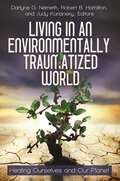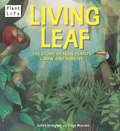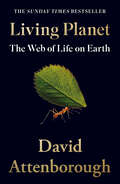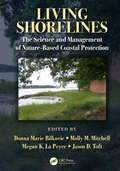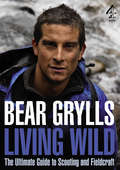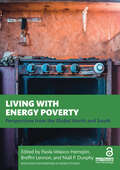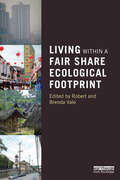- Table View
- List View
Living in an Environmentally Traumatized World: Healing Ourselves and Our Planet (Practical and Applied Psychology)
by Darlyne G. Nemeth Robert B. Hamilton Judy Kuriansky João Lucilio Ruegger de Albuquerque Gloria Alvernaz Mulcahy Robert A. Muller Donald F. Nemeth Anna T. Onishi Yasuo Onishi Alexander P. Steger L. Taighlor Whittington Susan ZelinskiThis book follows environmental changes—including those caused by human actions, as well as those resulting from natural circumstances—and provides a process to manage their impact on the future.Whenever environmental damages are caused by natural or human-made events, there are long-term effects for people. This eye-opening and unprecedented book explains the ongoing turmoil in the environment, while presenting ways to alleviate its effect on humankind's physical and mental health. Living in an Environmentally Traumatized World: Healing Ourselves and Our Planet discusses recent environmental events and examines the reasons why the resulting changes are inevitable. The authors assert that people experience six universal stages when they suffer from environmental trauma: shock, survivor mode, basic needs, awareness of loss, spin and fraud, and resolution. The book presents coping strategies for navigating negative ecological shifts, and provides a plan of action for responsibly managing our environment. Additionally, profiles of indigenous people who endure under environmental adversity provide real world examples of survival.
Living in an Environmentally Traumatized World: Healing Ourselves and Our Planet (Practical and Applied Psychology)
by Darlyne G. Nemeth Judy Kuriansky Robert B. HamiltonThis book follows environmental changes—including those caused by human actions, as well as those resulting from natural circumstances—and provides a process to manage their impact on the future.Whenever environmental damages are caused by natural or human-made events, there are long-term effects for people. This eye-opening and unprecedented book explains the ongoing turmoil in the environment, while presenting ways to alleviate its effect on humankind's physical and mental health. Living in an Environmentally Traumatized World: Healing Ourselves and Our Planet discusses recent environmental events and examines the reasons why the resulting changes are inevitable. The authors assert that people experience six universal stages when they suffer from environmental trauma: shock, survivor mode, basic needs, awareness of loss, spin and fraud, and resolution. The book presents coping strategies for navigating negative ecological shifts, and provides a plan of action for responsibly managing our environment. Additionally, profiles of indigenous people who endure under environmental adversity provide real world examples of survival.
Living in the Sound of the Wind: A Personal Quest for W.H. Hudson, Naturalist and Writer from the River Plate
by Jason WilsonW. H. Hudson was brought up on the pampas, where he learnt from gauchos about frontier life. After moving to London in 1874, Hudson lived in extreme poverty. Like his friend Joseph Conrad, Hudson was an exile, adapting to England. He never returned to Argentina.Wilson unravels Hudson’s English dream, his natural history rambles, and his work to protect birds. He remains both a complex witness to his homeland before mass immigration and to his England of the mind, before the urban sprawl.Praise for Jason Wilson: Tireless, shrewd, erudite Jason Wilson, mixing hard fact and anthology, provides the perfect outfit of allusion and comparative experience - Jonathan Keates, ObserverPut his treasure trove into your pocket. - Anthony Sattin, Sunday TimesThe idea is so simple that it must be original. This inaugural book might prove to be a landmark. - Nicholas Shakespeare, Daily Telegraph
Living Leaf: The Story of How Plants Grow and Survive (Plant Life)
by Judith HeneghanLooking at the amazing variety of plants around the world, this title focuses on the ingenious ways in which plants ensure that their leaves have access to sunlight, water and carbon dioxide so that they can photosynthesise, and how they deter creatures that may try to eat them.
The Living Mountain: A Celebration of the Cairngorm Mountains of Scotland (Canons #6)
by Nan ShepherdIn this masterpiece of nature writing, Nan Shepherd describes her journeys into the Cairngorm mountains of Scotland. There she encounters a world that can be breathtakingly beautiful at times and shockingly harsh at others. Her intense, poetic prose explores and records the rocks, rivers, creatures and hidden aspects of this remarkable landscape. Shepherd spent a lifetime in search of the 'essential nature' of the Cairngorms; her quest led her to write this classic meditation on the magnificence of mountains, and on our imaginative relationship with the wild world around us. Composed during the Second World War, the manuscript of The Living Mountain lay untouched for more than thirty years before it was finally published.
The Living Mountain: A Celebration Of The Cairngorm Mountains Of Scotland (Canons Ser. (PDF))
by Nan Shepherd Robert MacfarlaneIn this masterpiece of nature writing, Nan Shepherd describes her journeys into the Cairngorm mountains of Scotland. There she encounters a world that can be breathtakingly beautiful at times and shockingly harsh at others. Her intense, poetic prose explores and records the rocks, rivers, creatures and hidden aspects of this remarkable landscape. Shepherd spent a lifetime in search of the 'essential nature' of the Cairngorms; her quest led her to write this classic meditation on the magnificence of mountains, and on our imaginative relationship with the wild world around us. Composed during the Second World War, the manuscript of The Living Mountain lay untouched for more than thirty years before it was finally published.
The Living Mountain: A Celebration Of The Cairngorm Mountains Of Scotland (Canons Ser. (PDF))
by Nan Shepherd Robert MacfarlaneIn this masterpiece of nature writing, Nan Shepherd describes her journeys into the Cairngorm mountains of Scotland. There she encounters a world that can be breathtakingly beautiful at times and shockingly harsh at others. Her intense, poetic prose explores and records the rocks, rivers, creatures and hidden aspects of this remarkable landscape. Shepherd spent a lifetime in search of the 'essential nature' of the Cairngorms; her quest led her to write this classic meditation on the magnificence of mountains, and on our imaginative relationship with the wild world around us. Composed during the Second World War, the manuscript of The Living Mountain lay untouched for more than thirty years before it was finally published.
Living on Earth: Life, Consciousness and the Making of the Natural World
by null Peter Godfrey-SmithThe eagerly anticipated conclusion to Peter Godfrey-Smith’s three-part exploration of the origins of intelligence on Earth, which began with the bestselling Other Minds in 2018 and continued with Metazoa in 2020. The eagerly anticipated conclusion to Peter Godfrey-Smith’s three-part exploration of the origins of intelligence on Earth, which began with the bestselling Other Minds in 2018 and continued with Metazoa in 2020. Peter Godfrey-Smith, the scuba-diving philosopher, examined the evolution of sentience in Other Minds. In Metazoa he asked how that consciousness shaped and was shaped by animal bodies. Now, in Living on Earth, he takes that line of questioning a step further, asking, how has life shaped and been shaped by our planet? He visits the largest living stromatolite fields, examples of how cyanobacteria began belching oxygen into the atmosphere as they converted carbon dioxide and water into living matter using the sun's light. The extraordinary increase in oxygen in the atmosphere resulted in an explosion in the diversity of life. And so began a riotous tangle of coevolution between plants and animals, as each changed the environment around them allowing others to utilise these new ecosystems and thus new species to evolve. From cyanobacteria, through algae on to ferns or trees or grasses, and from protists , through invertebrates and fish through the dinosaurs and on to birds and mammals – our planet has seen an explosion of life forms, all reacting to their environment and all creating new environments that allow other life to evolve. In our own evolutionary line, an initially unremarkable mammal changed in new ways, evolving to come out of the trees to inhabit new savannas and then onto inhabit the whole planet. One of the most adaptable species ever found on Earth, and arguably the species causing the most change, humans are still part of this 3.8 billion year history of life forms changing the world around them. In Living on Earth, Godfrey-Smith takes us on a grand tour of the history of life on earth. He visits Rwandan gorillas and Australian bowerbirds, returns to coral reefs and octopus dens, considers the impact of language and writing, and weighs the responsibilities our unique powers bring with them, as they relate to factory farming, habitat preservation, climate change, and the use of animals in experiments. Living on Earth shows that Humans belong to the infinitely complex system that is the Earth, and our minds are products of that system, but we are also an acting force within it. We are creatures of Earth, but we hold Earth's future in our hands. It is a responsibility that we must all understand and accept.
A Living Past: Environmental Histories of Modern Latin America (Environment in History: International Perspectives #13)
by John Soluri, Claudia Leal José Augusto PáduaThough still a relatively young field, the study of Latin American environmental history is blossoming, as the contributions to this definitive volume demonstrate. Bringing together thirteen leading experts on the region, A Living Past synthesizes a wide range of scholarship to offer new perspectives on environmental change in Latin America and the Spanish Caribbean since the nineteenth century. Each chapter provides insightful, up-to-date syntheses of current scholarship on critical countries and ecosystems (including Brazil, Mexico, the Caribbean, the tropical Andes, and tropical forests) and such cross-cutting themes as agriculture, conservation, mining, ranching, science, and urbanization. Together, these studies provide valuable historical contexts for making sense of contemporary environmental challenges facing the region.
Living Planet: The Web Of Life On Earth
by David AttenboroughThe Sunday Times Bestseller A new, fully updated narrative edition of David Attenborough’s seminal biography of our world, The Living Planet.
Living Rivers: Trends and Challenges in Science and Management (Developments in Hydrobiology #187)
by E. W. R. Leuven A. M. J. Ragas A. J. M. Smits G. Van Der VeldeThis book demonstrates an integrated perspective of trends and challenges in sustainable river science and management, as presented by experts in the fields that form its foundations - ecology, economy and sociology. Their contributions integrate current knowledge of the structure, functioning and management of ‘living rivers’. Also included are data and experiences concerning the rivers Allier, Meuse, Rhine, Sava and Tagliamento in Europe and the Illinois River in the USA.
The Living Shore: Rediscovering a Lost World
by Rowan JacobsenIn the 1990s, a marine scientist named Brian Kingzett was commissioned to survey Canada's western coast. He saw amazing sights, from the wildest, most breathtaking coasts to the smallest of marine creatures. Along the western side of Vancouver Island, Kingzett nosed into an isolated pocket beach where he found something unusual. Amid the mussels, barnacles, and clams were round oysters-Olympias. Kingzett noted their presence and paddled on. A decade later when he met Betsy Peabody, executive director of the Puget Sound Restoration Fund (PSRF), he learned that this once ubiquitous native oyster was in steep decline, and he knew that together they would return to this remote spot.Rowan Jacobsen, along with Kingzett, Peabody, and a small group of scientists from PSRF and the Nature Conservancy, set out last July to see if the Olys were still surviving-and if they were, what they could learn from them. The goal: to use their pristine natural beds, which have probably been around for millennia, as blueprints for the habitat restoration efforts in Puget Sound. The implications are vast. If Peabody and her team can bring good health back to Puget Sound by restoring the intertidal zones-the areas of land exposed during low tide and submerged during high tide, where oysters live-their research could serve as a model for saving the world's oceans.During a time when the fate of the oceans seems uncertain, Rowan Jacobsen has found hope in the form of a small shelled creature living in the lost world where all life began.
Living Shorelines: The Science and Management of Nature-Based Coastal Protection (CRC Marine Science)
by Donna Marie Bilkovic Molly M. Mitchell Megan K. La Peyre Jason D. ToftKey features: Makes recommendations on the correct usage of the term living shorelines Offers guidance for shoreline management in the future Includes lessons learned from the practice of shoreline restoration/conservation Synthesizes regional perspectives to identify strategies for the successful design and implementation of living shorelines Reviews specific design criteria for successful implementation of living shorelines Provides detailed discussions of social, regulatory, scientific and technical considerations to justify and design living shoreline projects Living Shorelines: The Science and Management of Nature-based Coastal Protection compiles, synthesizes and interprets the current state of the knowledge on the science and practice of nature-based shoreline protection. This book will serve as a valuable reference to guide scientists, students, managers, planners, regulators, environmental and engineering consultants, and others engaged in the design and implementation of living shorelines. This volume provides a background and history of living shorelines, understandings on management, policy, and project designs, technical synthesis of the science related to living shorelines including insights from new studies, and the identification of research needs, lessons learned, and perspectives on future guidance. International perspectives are presented from leading researchers and managers in the East, West and Gulf coasts of the United States, Europe, Canada, and Australia that are working on natural approaches to shoreline management. The broad geographic scope and interdisciplinary nature of contributing authors will help to facilitate dialogue and transfer knowledge among different disciplines and across different regions. This book will provide coastal communities with the scientific foundation and practical guidance necessary to implement effective shoreline management that enhances ecosystem services and coastal resilience now and into the future.
Living Shorelines: The Science and Management of Nature-Based Coastal Protection (CRC Marine Science)
by Donna Marie Bilkovic Molly M. Mitchell Megan K. La Peyre Jason D. ToftKey features: Makes recommendations on the correct usage of the term living shorelines Offers guidance for shoreline management in the future Includes lessons learned from the practice of shoreline restoration/conservation Synthesizes regional perspectives to identify strategies for the successful design and implementation of living shorelines Reviews specific design criteria for successful implementation of living shorelines Provides detailed discussions of social, regulatory, scientific and technical considerations to justify and design living shoreline projects Living Shorelines: The Science and Management of Nature-based Coastal Protection compiles, synthesizes and interprets the current state of the knowledge on the science and practice of nature-based shoreline protection. This book will serve as a valuable reference to guide scientists, students, managers, planners, regulators, environmental and engineering consultants, and others engaged in the design and implementation of living shorelines. This volume provides a background and history of living shorelines, understandings on management, policy, and project designs, technical synthesis of the science related to living shorelines including insights from new studies, and the identification of research needs, lessons learned, and perspectives on future guidance. International perspectives are presented from leading researchers and managers in the East, West and Gulf coasts of the United States, Europe, Canada, and Australia that are working on natural approaches to shoreline management. The broad geographic scope and interdisciplinary nature of contributing authors will help to facilitate dialogue and transfer knowledge among different disciplines and across different regions. This book will provide coastal communities with the scientific foundation and practical guidance necessary to implement effective shoreline management that enhances ecosystem services and coastal resilience now and into the future.
Living Wild: The Ultimate Guide to Scouting and Fieldcraft
by Bear GryllsThe complete guide to living in the wild from the ultimate survival expertIn this essential guide to living wild, Bear Grylls reveals the secrets of his years of fieldcraft experience. This is the information you really need to know about living in the field from the man who has passed 21 SAS selection, climbed Everest and survived in some of the most inhospitable regions on Earth. In his inimitable style, Bear has thrown out everything that's boring about scouting and fieldcraft and concentrated only on what's exciting, inspirational and a little bit edgy. It's all here, from mastering the art of making the perfect campfire and constructing the best camp, to navigating safely through all terrains in all weathers - with or without a map...The only other thing you'll need is this book!Bear Grylls served for three years with the British Special Forces - 21 SAS. He is a world-record-breaking adventurer, a bestselling author and one of the world's most sought-after motivational speakers. Bear's prime-time adventure tv series reaches over a bilion viewers worldwide in over 150 countries. He was recently awarded an honorary commission as a Lieutenant-Commander in the Royal Navy for his endeavours with both adventure and charity. He is married to Shara and they have three sons, Jesse, Marmaduke and Huckleberry.
Living with Energy Poverty: Perspectives from the Global North and South (Routledge Explorations in Energy Studies)
by Paola Velasco-Herrejón Breffní Lennon Niall P. DunphyLiving with Energy Poverty: Perspectives from the Global North and South expands our collective understanding of energy poverty and deepens our recognition of the phenomenon by engaging with the lived experiences of energy-poor households across different contexts.Understanding the lived experience of energy poverty is an essential component in the design of any effort to alleviate what is fundamentally a deep-rooted, multi-faceted, wickedly complex problem. This requires a nuanced understanding of the causal factors and the research methods that can respond to the flexible spatial and temporal nature of the condition, as well as its wellbeing and justice implications. Drawing together the expertise and connectedness of authors from the Global South and North, this book presents novel approaches to understanding the often hidden forms of domestic energy deprivation. Case studies from 20 countries provide critical perspectives on this phenomenon while analysing the policy practices, government strategy, and sustainability implications of divergent manifestations. The book takes a multidimensional perspective, challenging the bias towards energy production and service provision, which often do not align with the aspirations and realities of energy households across global contexts, thus facilitating a useful dialogue on the nature of energy poverty.The book is a timely source for policymakers, practitioners, and scholars seeking fresh, diverse insights into the everyday reality of energy poverty and wanting to better understand the challenges a people-centred, just energy transition can present.Chapter 1 of this book is freely available as a downloadable Open Access PDF at http://www.taylorfrancis.com under a Creative Commons [Attribution-Non Commercial-No Derivatives (CC-BY-NC-ND)] 4.0 license.Chapter 2 of this book is freely available as a downloadable Open Access PDF at http://www.taylorfrancis.com under a Creative Commons [Attribution-Non Commercial-No Derivatives (CC-BY-NC-ND)] 4.0 license.Chapter 22 of this book is freely available as a downloadable Open Access PDF at http://www.taylorfrancis.com under a Creative Commons [Attribution-Non Commercial-No Derivatives (CC-BY-NC-ND)] 4.0 license.
Living with Energy Poverty: Perspectives from the Global North and South (Routledge Explorations in Energy Studies)
Living with Energy Poverty: Perspectives from the Global North and South expands our collective understanding of energy poverty and deepens our recognition of the phenomenon by engaging with the lived experiences of energy-poor households across different contexts.Understanding the lived experience of energy poverty is an essential component in the design of any effort to alleviate what is fundamentally a deep-rooted, multi-faceted, wickedly complex problem. This requires a nuanced understanding of the causal factors and the research methods that can respond to the flexible spatial and temporal nature of the condition, as well as its wellbeing and justice implications. Drawing together the expertise and connectedness of authors from the Global South and North, this book presents novel approaches to understanding the often hidden forms of domestic energy deprivation. Case studies from 20 countries provide critical perspectives on this phenomenon while analysing the policy practices, government strategy, and sustainability implications of divergent manifestations. The book takes a multidimensional perspective, challenging the bias towards energy production and service provision, which often do not align with the aspirations and realities of energy households across global contexts, thus facilitating a useful dialogue on the nature of energy poverty.The book is a timely source for policymakers, practitioners, and scholars seeking fresh, diverse insights into the everyday reality of energy poverty and wanting to better understand the challenges a people-centred, just energy transition can present.Chapter 1 of this book is freely available as a downloadable Open Access PDF at http://www.taylorfrancis.com under a Creative Commons [Attribution-Non Commercial-No Derivatives (CC-BY-NC-ND)] 4.0 license.Chapter 2 of this book is freely available as a downloadable Open Access PDF at http://www.taylorfrancis.com under a Creative Commons [Attribution-Non Commercial-No Derivatives (CC-BY-NC-ND)] 4.0 license.Chapter 22 of this book is freely available as a downloadable Open Access PDF at http://www.taylorfrancis.com under a Creative Commons [Attribution-Non Commercial-No Derivatives (CC-BY-NC-ND)] 4.0 license.
Living with Environmental Change: Waterworlds
by Kirsten Hastrup Cecilie RubowClimate change is a lived experience of changes in the environment, often destroying conventional forms of subsistence and production, creating new patterns of movement and connection, and transforming people’s imagined future. This book explores how people across the world think about environmental change and how they act upon the perception of past, present and future opportunities. Drawing on the ethnographic fieldwork of expert authors, it sheds new light on the human experience of and social response to climate change by taking us from the Arctic to the Pacific, from the Southeast Indian Coastal zone to the West-African dry-lands and deserts, as well as to Peruvian mountain communities and cities. Divided into four thematic parts - Water, Landscape, Technology, Time – this book uses rich photographic material to accompany the short texts and reflections in order to bring to life the human ingenuity and social responsibility of people in the face of new uncertainties. In an era of melting glaciers, drying lands, and rising seas, it shows how it is part and parcel of human life to take responsibility for the social community and take creative action on the basis of a localized understanding of the environment. This highly original contribution to the anthropological study of climate change is a must-read for all those wanting to understand better what climate change means on the ground and interested in a sustainable future for the Earth.
Living with Environmental Change: Waterworlds
by Kirsten Hastrup Cecilie RubowClimate change is a lived experience of changes in the environment, often destroying conventional forms of subsistence and production, creating new patterns of movement and connection, and transforming people’s imagined future. This book explores how people across the world think about environmental change and how they act upon the perception of past, present and future opportunities. Drawing on the ethnographic fieldwork of expert authors, it sheds new light on the human experience of and social response to climate change by taking us from the Arctic to the Pacific, from the Southeast Indian Coastal zone to the West-African dry-lands and deserts, as well as to Peruvian mountain communities and cities. Divided into four thematic parts - Water, Landscape, Technology, Time – this book uses rich photographic material to accompany the short texts and reflections in order to bring to life the human ingenuity and social responsibility of people in the face of new uncertainties. In an era of melting glaciers, drying lands, and rising seas, it shows how it is part and parcel of human life to take responsibility for the social community and take creative action on the basis of a localized understanding of the environment. This highly original contribution to the anthropological study of climate change is a must-read for all those wanting to understand better what climate change means on the ground and interested in a sustainable future for the Earth.
Living with the Earth, Fourth Edition: Concepts in Environmental Health Science
by Gary S. Moore Kathleen A. BellShelving Guide; Environmental ScienceThis is a groundbreaking and innovative book now in its fourth edition. The first edition won the CHOICE award for outstanding Academic Book while editions two and three became bestsellers on their own right. This fourth edition is packed with new updates on current world events associated with environmental issues and related health concerns. The author maintains traditional concepts and merges them with new and controversial issues. The book has been revised to include up-to-date topics with and a revised Web site with updated links.So what Coverage of emergency preparedness for environmental health practitioners Discussion of population dynamics especially with regard to overpopulation and underpopulation around the world and their respective influences on social, economic, and environmental concerns. The mechanisms of environmental disease, emphasizing genetic disease and its role in developmental disorders and cancer. Human behaviors and pollution are presented along with respect to their roles in cancer risk. The ever increasing issues surrounding emerging and re-emerging diseases around the earth and the introduction of an increasing number of emerging diseases. The growing problems of asthma and other health effects associated with air pollution. An exploration of the mechanisms of toxicity with special reference to the immune system and endocrine disruption. The ongoing issues of the creation and disposal of hazardous waste along with the controversies surrounding disposal are presented. The issues and benefits of recycling are explored. The use of HACCP in assuring food quality, food safety issues, and the Food Quality Protection Act are discussed. Numerous technical illustrations, charts, graphs, and photographs are included What on the Web? Test bank and study questions giving a complete review of the concepts covered. Search tools for online journals and databases covering useful, up-to-date information in health and environmental topics Subject specific links by chapter as well as Federal, state, and organization sites with relevant information Downloadable PowerPoint files for each Chapter providing the instructor with ready-made presentation materials that can be modified as needed. Downloadable and printable test questions and answers for each chapter available to instructors
Living with the Earth, Fourth Edition: Concepts in Environmental Health Science
by Gary S. Moore Kathleen A. BellShelving Guide; Environmental ScienceThis is a groundbreaking and innovative book now in its fourth edition. The first edition won the CHOICE award for outstanding Academic Book while editions two and three became bestsellers on their own right. This fourth edition is packed with new updates on current world events associated with environmental issues and related health concerns. The author maintains traditional concepts and merges them with new and controversial issues. The book has been revised to include up-to-date topics with and a revised Web site with updated links.So what Coverage of emergency preparedness for environmental health practitioners Discussion of population dynamics especially with regard to overpopulation and underpopulation around the world and their respective influences on social, economic, and environmental concerns. The mechanisms of environmental disease, emphasizing genetic disease and its role in developmental disorders and cancer. Human behaviors and pollution are presented along with respect to their roles in cancer risk. The ever increasing issues surrounding emerging and re-emerging diseases around the earth and the introduction of an increasing number of emerging diseases. The growing problems of asthma and other health effects associated with air pollution. An exploration of the mechanisms of toxicity with special reference to the immune system and endocrine disruption. The ongoing issues of the creation and disposal of hazardous waste along with the controversies surrounding disposal are presented. The issues and benefits of recycling are explored. The use of HACCP in assuring food quality, food safety issues, and the Food Quality Protection Act are discussed. Numerous technical illustrations, charts, graphs, and photographs are included What on the Web? Test bank and study questions giving a complete review of the concepts covered. Search tools for online journals and databases covering useful, up-to-date information in health and environmental topics Subject specific links by chapter as well as Federal, state, and organization sites with relevant information Downloadable PowerPoint files for each Chapter providing the instructor with ready-made presentation materials that can be modified as needed. Downloadable and printable test questions and answers for each chapter available to instructors
Living with the Unexpected: Linking Disaster Recovery to Sustainable Development in Montserrat
by Anja PossekelLiving with the Unexpected deals with complexity and uncertainty, two major challenges in a world faced with climate change and hazards. The study focuses on appropriate methods which enable vulnerable communities to cope effectively with natural hazards and disasters. The central goal of the book is an applicable combination of hazard management and development planning. Therefore, the reconstruction process following a disaster is understood as an opportunity for structural changes and self-organisation processes that foster sustainable development. In this context the potential of scenario planning as an evolutionary and participatory learning approach is addressed. The empirical research concentrates on the time before and during the volcanic crisis on the Caribbean Island Montserrat. Particular methods used are a systematic analysis of the complex system Montserrat, more than 200 interviews with stakeholders and citizens – concentrating on resource and hazard perceptions – as well as the organization and execution of various scenario workshops. The study shows that the opportunity to realise sustainable development on the island with the help of a participative, adaptive reconstruction process is better than ever. The population is sensitised to disasters and an uncertain future. Their preparedness to accept measures which are designed to reduce their vulnerability is high. This book demonstrates how we can learn to live with the Unexpeted.
Living with water: Everyday encounters and liquid connections
by Charlotte Bates Kate MolesLiving with water brings together sociologists, geographers, artists, writers and poets to explore the ways in which water binds, immerses and supports us. Drawing from international research on river crossings, boat dwelling, wild swimming, sea fishing, and drought impacts, and navigating urban waters, glacial lagoons, barrier reefs and disappearing tarns, the collection illuminates the ways that we live with and without water, and explores how we can think and write with water on land. Water offers a way of attending to emerging and enduring social and ecological concerns and making sense of them in lively and creative ways. By approaching Living with water from different disciplinary and methodological perspectives, and drawing on research from around the world, this collection opens up discussions that reinvigorate and renew previously landlocked debates.This book is relevant to United Nations Sustainable Development Goal 6, Clean water and sanitation
Living with water: Everyday encounters and liquid connections
by Charlotte Bates and Kate MolesLiving with water brings together sociologists, geographers, artists, writers and poets to explore the ways in which water binds, immerses and supports us. Drawing from international research on river crossings, boat dwelling, wild swimming, sea fishing, and drought impacts, and navigating urban waters, glacial lagoons, barrier reefs and disappearing tarns, the collection illuminates the ways that we live with and without water, and explores how we can think and write with water on land. Water offers a way of attending to emerging and enduring social and ecological concerns and making sense of them in lively and creative ways. By approaching Living with water from different disciplinary and methodological perspectives, and drawing on research from around the world, this collection opens up discussions that reinvigorate and renew previously landlocked debates.This book is relevant to United Nations Sustainable Development Goal 6, Clean water and sanitation
Living within a Fair Share Ecological Footprint
by Robert Vale Brenda ValeAccording to many authorities the impact of humanity on the earth is already overshooting the earth’s capacity to supply humanity’s needs. This is an unsustainable position. This book does not focus on the problem but on the solution, by showing what it is like to live within a fair earth share ecological footprint. The authors describe numerical methods used to calculate this, concentrating on low or no cost behaviour change, rather than on potentially expensive technological innovation. They show what people need to do now in regions where their current lifestyle means they are living beyond their ecological means, such as in Europe, North America and Australasia. The calculations focus on outcomes rather than on detailed discussion of the methods used. The main objective is to show that living with a reduced ecological footprint is both possible and not so very different from the way most people currently live in the west. The book clearly demonstrates that change in behaviour now will avoid some very challenging problems in the future. The emphasis is on workable, practical and sustainable solutions based on quantified research, rather than on generalities about overall problems facing humanity.
